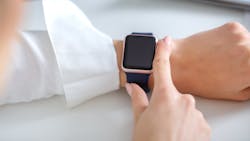Wearable electronics worn by consumers often include health and fitness tracking devices, but also watches, jewelry, clothing, implantable devices and head-mounted displays. The medical world is no lightweight in this area, employing smart patches, smart pills, and other wearables for the treatment of chronic diseases and remote telemedicine.
Here are some news updates on developments in wearables.
Report: Wearables market $61.4 billion by 2025
The global market for wearable electronics is predicted to hit $61.4 billion by 2025, according to a report by ReportLinker. Expected driving forces will be “inexpensive sensors, miniaturized yet powerful microchips and processors, low-power, lighter electric components, and the expansion of applications addressed by wearable products and services,” the report says. The greatest impact on industry growth will be in medical electronic wearables, which will enhance digital medical telehealth, according to the report.1
Fish scales could make wearable electronics more sustainable
New research in the American Chemical Society’s ACS Nano describes a method to create electronic displays such as a glowing tattoo or a digital readout on human skin—using fish scales. Up to now, electricity-conducting and light-emitting components have been layered onto transparent plastic film, to make them flexible enough to stay on skin or other soft surfaces. The ACS Nano article describes how to make such displays, which would likely be disposable after one use. Researchers Hai-Dong Yu, Juaing Liu, Wei Huang and colleages settled on a gelatin derived from collagen found in fish scales, which was fashioned into a film. An attractive aspect of the film is that it is unlikely to linger in landfills after use, as it dissolves within seconds when immersed in hot water. When buried in soil, it degrades within 24 days. The researchers built a working AC electronluminescent device that continued to glow, even after being bent and relaxed 1,000 times.2
Ford tests buzzing wristbands for social distancing
Maybe the production lines aren’t churning out vehicles at Ford Motor Company, but the auto giant is getting ready for renewed activity on wheeled products when the COVID-19 threat diminishes.
At a Ford factory in Plymouth, MI, a dozen workers are testing watch-like wearables that vibrate when workers come within 6 feet of each other. The object is to keep workers outside the distance recommended by health experts to avoid spreading the coronavirus.
The social-distancing gizmo could be part of new Ford safety protocols, developed in cooperation with the UAW, when it resumes production as soon as next month, following a six-week shutdown. Also under consideration is thermal imaging scanning to detect fevers.
The smartwatches, manufactured by Samsung Electronics Co., and using software from Austin-based Radiant RFID, use Bluetooth short-wave and low-power technology to identify proximity and clustering of employees. The devices deliver vibration and color-coded warnings when workers are closer than the 6-foot recommended distance.
Ford has been producing respirators to supply hospitals fighting the Covid-19 pandemic.3
Stretchable supercapacitors show promise
A novel supercapacitor that remains functional even when stretched to eight times its original size has been developed by researchers at Duke University and Michigan State University. It reportedly doesn’t exhibit ill effects from repeated stretching, and maintains all but a few percentage points of energy performance after 10,000 cycles of charging and discharging. The researchers anticipate the supercapacitors being used as part of a power-independent, stretchable, flexible electronic system that could be used in wearables and biomedical devices.
To create the supercapacitors, the team grew a carbon nanotube “forest” on top of a silicon wafer, coated a thin layer of gold nanofilm on top of the carbon nanotube forest. Then a coat of gold nanofilm was applied to the forest, which was then transferred to a prestretched elastomer substrate. The gel-filled electrode was allowed to relax, which crumpled the gold layer and condensed the “trees” in the forest. When the resulting dense forest is filled with a gel electrolyte, it was able to trap electrons on the surface of the nanotubes. The research found that when two of these final electrodes were sandwiched close together, voltage could be loaded onto one side with electrons while the other was drained.4
References
1. ReportLinker “Global Wearable Electronics Industry,” December, 2019,
https://www.prnewswire.com/news-releases/global-wearable-electronics-industry-300992723.html
2. ACS Nano, “Fish scales could make wearable electronics more Sustainable,” March 18, 2020, https://www.acs.org/content/acs/en/pressroom/presspacs/2020/acs-presspac-march-18-2020/fish-scales-could-make-wearable-electronics-more-sustainable.html
3. Bloomberg, April 15, 2020, “Ford Tests Buzzing Wristbands to Keep Workers at Safe Distances,” https://www.bloomberg.com/news/articles/2020-04-15/ford-tests-buzzing-distancing-wristbands-to-keep-workers-apart
4. Pratt School of Engineering, “Stretchable superconductors to power Tomorrow’s Wearable Devices,” March 19, 2020, https://pratt.duke.edu/about/news/stretchable-supercapacitors
